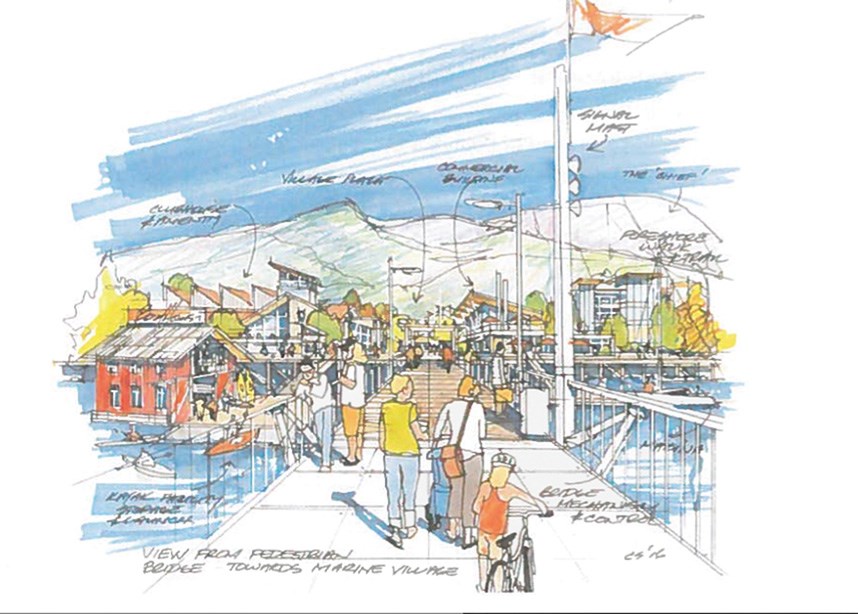Waterfront Landing
The first set of public hearings on the Waterfront Landing project saw a mixed array of responses from the public.
Public hearings on zoning and Official Community Plan amendment bylaws needed for the Waterfront Landing proposal, slated for 1500 Highway 99 along the east side of the Mamquam Blind Channel, were held at the Squamish Seniors’ Activity Centre Tuesday night.
Squamish resident and business owner Jeff Levine told council higher density housing downtown, such as what Waterfront Landing offers, is needed.
“As a business owner, we are having a very hard time attracting employees,” he said. “Unfortunately, with housing prices in Squamish and how they are going up it seems, every day, it is pricing the newcomers to Squamish and the longtime locals out of town.”
The Waterfront Landing proposal includes approximately 950 units of housing with a mix of housing types contemplated: duplexes, townhouses and apartments.
The project previously passed two readings of bylaws required for approval.
Since the second reading some changes were made to the plan.
Five units of affordable housing were added to the original 50 units of rentals; the developer also proposed a partnership with the school district to provide a bus to school for students until a planned pedestrian bridge across the channel is built.
The development will roll out in seven phases.
The pedestrian bridge over the Mamquam Blind Channel to connect the project to downtown is scheduled for the second phase of the project.
A total of $6.8 million in community amenity contributions is included in the proposal.
Speaker Jack Cooley, of the Squamish Streamkeepers Society, praised the project’s developers, Bosa and Kingswood Properties, for the work done removing 400 creosote pilings from the Mamquam Blind Channel.
“Also, they got rid of some derelict vessels,” he said, noting that the developers didn’t wait until their project was approved to do the work.
Resident Hans Christian Montenegro, who lives in the condos across the water from the project in Marina Estates, shared his concerns about Waterfront Landing’s building heights and increased traffic. Building heights will be staggered, according to District staff, with lower heights planned for closer to the water and a maximum of six-storeys planned for the periphery and road-side of the project.
He also questioned whether more residential housing will be helpful for Squamish’s economy.
“We have already a lot of residential developments downtown,” he said, adding people need places to work.
Eric Andersen, who represents the forest industry on the Squamish Estuary Management Committee, submitted written concerns of the committee.
One concern is that there is no light industry proposed in the project, even though there was industry in an earlier proposal.
“The fact that the developer proposed to remove all of the marine light industry from the present Waterfront Landing sub area plan bylaw without any comment from the District is disappointing,” Andersen told The Chief prior to the hearing.
While originally council was going to consider third reading on the project Tuesday night, that vote was postponed due to an error that meant public notifications about the hearings did not include the start time of the hearings. Therefore, a repeat public hearing will take place on July 11 at 6 p.m. at the Seniors Centre.
A second set of hearings, unrelated to Waterfront, will also be held on July 11. Former Squamish mayor Greg Gardner is proposing to rezone his property at 41601 Brennan Rd. in Brackendale for 35 single-unit dwelling lots.
Enforcing bylaws
District bylaws will soon be more efficiently enforced thanks to new positions that were recently approved.
A total of two new part-time bylaw staff were approved in the 2017 budget.
The District staff positions are key to the upcoming Bylaw Adjudication Process that is about to be rolled out, according Christina Moore, communications manager for the District.
The aim of hiring for the new positions and the new process is to improve the bylaw department’s capacity to respond to complaints, attend to community issues and conduct enforcement, Moore said.
Bylaw officers have always had the ability to write tickets and levy fines, however, the process of how the tickets are issued and disputed is being improved and streamlined, she said. The District will be rolling out information on this new system in the next few weeks.



